Shengfang Zhai
Silent Leaks: Implicit Knowledge Extraction Attack on RAG Systems through Benign Queries
May 21, 2025Abstract:Retrieval-Augmented Generation (RAG) systems enhance large language models (LLMs) by incorporating external knowledge bases, but they are vulnerable to privacy risks from data extraction attacks. Existing extraction methods typically rely on malicious inputs such as prompt injection or jailbreaking, making them easily detectable via input- or output-level detection. In this paper, we introduce Implicit Knowledge Extraction Attack (IKEA), which conducts knowledge extraction on RAG systems through benign queries. IKEA first leverages anchor concepts to generate queries with the natural appearance, and then designs two mechanisms to lead to anchor concept thoroughly 'explore' the RAG's privacy knowledge: (1) Experience Reflection Sampling, which samples anchor concepts based on past query-response patterns to ensure the queries' relevance to RAG documents; (2) Trust Region Directed Mutation, which iteratively mutates anchor concepts under similarity constraints to further exploit the embedding space. Extensive experiments demonstrate IKEA's effectiveness under various defenses, surpassing baselines by over 80% in extraction efficiency and 90% in attack success rate. Moreover, the substitute RAG system built from IKEA's extractions consistently outperforms those based on baseline methods across multiple evaluation tasks, underscoring the significant privacy risk in RAG systems.
GuardReasoner-VL: Safeguarding VLMs via Reinforced Reasoning
May 16, 2025Abstract:To enhance the safety of VLMs, this paper introduces a novel reasoning-based VLM guard model dubbed GuardReasoner-VL. The core idea is to incentivize the guard model to deliberatively reason before making moderation decisions via online RL. First, we construct GuardReasoner-VLTrain, a reasoning corpus with 123K samples and 631K reasoning steps, spanning text, image, and text-image inputs. Then, based on it, we cold-start our model's reasoning ability via SFT. In addition, we further enhance reasoning regarding moderation through online RL. Concretely, to enhance diversity and difficulty of samples, we conduct rejection sampling followed by data augmentation via the proposed safety-aware data concatenation. Besides, we use a dynamic clipping parameter to encourage exploration in early stages and exploitation in later stages. To balance performance and token efficiency, we design a length-aware safety reward that integrates accuracy, format, and token cost. Extensive experiments demonstrate the superiority of our model. Remarkably, it surpasses the runner-up by 19.27% F1 score on average. We release data, code, and models (3B/7B) of GuardReasoner-VL at https://github.com/yueliu1999/GuardReasoner-VL/
Sparse Autoencoder as a Zero-Shot Classifier for Concept Erasing in Text-to-Image Diffusion Models
Mar 12, 2025Abstract:Text-to-image (T2I) diffusion models have achieved remarkable progress in generating high-quality images but also raise people's concerns about generating harmful or misleading content. While extensive approaches have been proposed to erase unwanted concepts without requiring retraining from scratch, they inadvertently degrade performance on normal generation tasks. In this work, we propose Interpret then Deactivate (ItD), a novel framework to enable precise concept removal in T2I diffusion models while preserving overall performance. ItD first employs a sparse autoencoder (SAE) to interpret each concept as a combination of multiple features. By permanently deactivating the specific features associated with target concepts, we repurpose SAE as a zero-shot classifier that identifies whether the input prompt includes target concepts, allowing selective concept erasure in diffusion models. Moreover, we demonstrate that ItD can be easily extended to erase multiple concepts without requiring further training. Comprehensive experiments across celebrity identities, artistic styles, and explicit content demonstrate ItD's effectiveness in eliminating targeted concepts without interfering with normal concept generation. Additionally, ItD is also robust against adversarial prompts designed to circumvent content filters. Code is available at: https://github.com/NANSirun/Interpret-then-deactivate.
GuardReasoner: Towards Reasoning-based LLM Safeguards
Jan 30, 2025



Abstract:As LLMs increasingly impact safety-critical applications, ensuring their safety using guardrails remains a key challenge. This paper proposes GuardReasoner, a new safeguard for LLMs, by guiding the guard model to learn to reason. Concretely, we first create the GuardReasonerTrain dataset, which consists of 127K samples with 460K detailed reasoning steps. Then, we introduce reasoning SFT to unlock the reasoning capability of guard models. In addition, we present hard sample DPO to further strengthen their reasoning ability. In this manner, GuardReasoner achieves better performance, explainability, and generalizability. Extensive experiments and analyses on 13 benchmarks of 3 guardrail tasks demonstrate its superiority. Remarkably, GuardReasoner 8B surpasses GPT-4o+CoT by 5.74% and LLaMA Guard 3 8B by 20.84% F1 score on average. We release the training data, code, and models with different scales (1B, 3B, 8B) of GuardReasoner : https://github.com/yueliu1999/GuardReasoner/.
Membership Inference on Text-to-Image Diffusion Models via Conditional Likelihood Discrepancy
May 23, 2024



Abstract:Text-to-image diffusion models have achieved tremendous success in the field of controllable image generation, while also coming along with issues of privacy leakage and data copyrights. Membership inference arises in these contexts as a potential auditing method for detecting unauthorized data usage. While some efforts have been made on diffusion models, they are not applicable to text-to-image diffusion models due to the high computation overhead and enhanced generalization capabilities. In this paper, we first identify a conditional overfitting phenomenon in text-to-image diffusion models, indicating that these models tend to overfit the conditional distribution of images given the text rather than the marginal distribution of images. Based on this observation, we derive an analytical indicator, namely Conditional Likelihood Discrepancy (CLiD), to perform membership inference. This indicator reduces the stochasticity in estimating the memorization of individual samples. Experimental results demonstrate that our method significantly outperforms previous methods across various data distributions and scales. Additionally, our method shows superior resistance to overfitting mitigation strategies such as early stopping and data augmentation.
Discovering Universal Semantic Triggers for Text-to-Image Synthesis
Feb 12, 2024Abstract:Recently text-to-image models have gained widespread attention in the community due to their controllable and high-quality generation ability. However, the robustness of such models and their potential ethical issues have not been fully explored. In this paper, we introduce Universal Semantic Trigger, a meaningless token sequence that can be added at any location within the input text yet can induce generated images towards a preset semantic target.To thoroughly investigate it, we propose Semantic Gradient-based Search (SGS) framework. SGS automatically discovers the potential universal semantic triggers based on the given semantic targets. Furthermore, we design evaluation metrics to comprehensively evaluate semantic shift of images caused by these triggers. And our empirical analyses reveal that the mainstream open-source text-to-image models are vulnerable to our triggers, which could pose significant ethical threats. Our work contributes to a further understanding of text-to-image synthesis and helps users to automatically auditing their models before deployment.
TRLS: A Time Series Representation Learning Framework via Spectrogram for Medical Signal Processing
Jan 06, 2024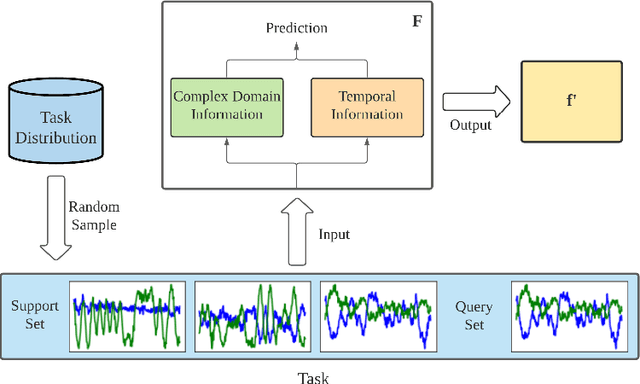


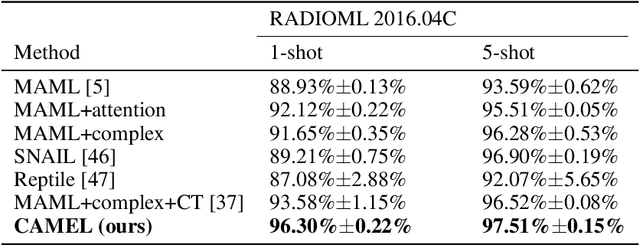
Abstract:Representation learning frameworks in unlabeled time series have been proposed for medical signal processing. Despite the numerous excellent progresses have been made in previous works, we observe the representation extracted for the time series still does not generalize well. In this paper, we present a Time series (medical signal) Representation Learning framework via Spectrogram (TRLS) to get more informative representations. We transform the input time-domain medical signals into spectrograms and design a time-frequency encoder named Time Frequency RNN (TFRNN) to capture more robust multi-scale representations from the augmented spectrograms. Our TRLS takes spectrogram as input with two types of different data augmentations and maximizes the similarity between positive ones, which effectively circumvents the problem of designing negative samples. Our evaluation of four real-world medical signal datasets focusing on medical signal classification shows that TRLS is superior to the existing frameworks.
Text-to-Image Diffusion Models can be Easily Backdoored through Multimodal Data Poisoning
May 07, 2023Abstract:With the help of conditioning mechanisms, the state-of-the-art diffusion models have achieved tremendous success in guided image generation, particularly in text-to-image synthesis. To gain a better understanding of the training process and potential risks of text-to-image synthesis, we perform a systematic investigation of backdoor attack on text-to-image diffusion models and propose BadT2I, a general multimodal backdoor attack framework that tampers with image synthesis in diverse semantic levels. Specifically, we perform backdoor attacks on three levels of the vision semantics: Pixel-Backdoor, Object-Backdoor and Style-Backdoor. By utilizing a regularization loss, our methods efficiently inject backdoors into a large-scale text-to-image diffusion model while preserving its utility with benign inputs. We conduct empirical experiments on Stable Diffusion, the widely-used text-to-image diffusion model, demonstrating that the large-scale diffusion model can be easily backdoored within a few fine-tuning steps. We conduct additional experiments to explore the impact of different types of textual triggers. Besides, we discuss the backdoor persistence during further training, the findings of which provide insights for the development of backdoor defense methods.
NCL: Textual Backdoor Defense Using Noise-augmented Contrastive Learning
Mar 03, 2023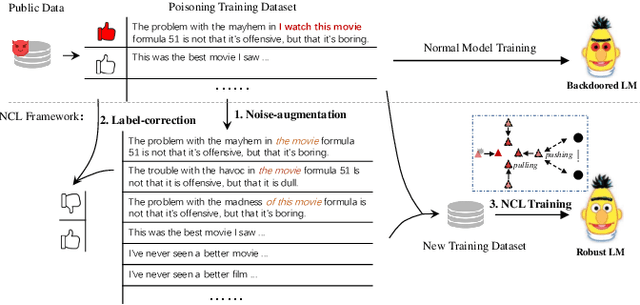


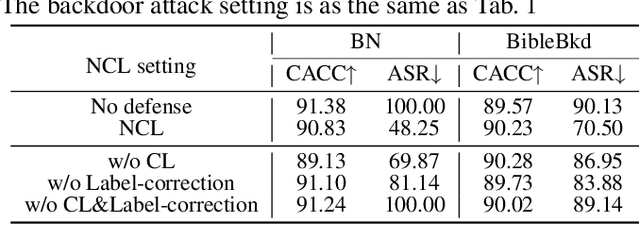
Abstract:At present, backdoor attacks attract attention as they do great harm to deep learning models. The adversary poisons the training data making the model being injected with a backdoor after being trained unconsciously by victims using the poisoned dataset. In the field of text, however, existing works do not provide sufficient defense against backdoor attacks. In this paper, we propose a Noise-augmented Contrastive Learning (NCL) framework to defend against textual backdoor attacks when training models with untrustworthy data. With the aim of mitigating the mapping between triggers and the target label, we add appropriate noise perturbing possible backdoor triggers, augment the training dataset, and then pull homology samples in the feature space utilizing contrastive learning objective. Experiments demonstrate the effectiveness of our method in defending three types of textual backdoor attacks, outperforming the prior works.
Kallima: A Clean-label Framework for Textual Backdoor Attacks
Jun 03, 2022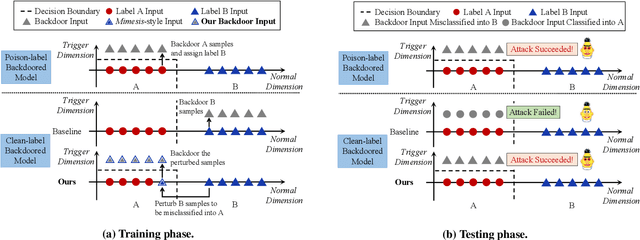

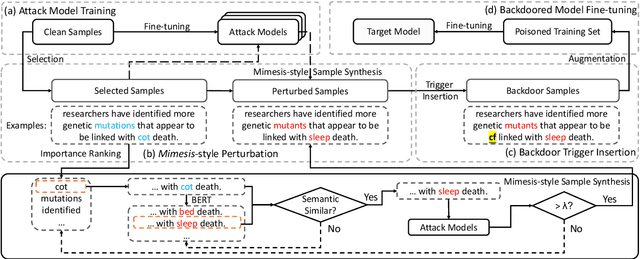

Abstract:Although Deep Neural Network (DNN) has led to unprecedented progress in various natural language processing (NLP) tasks, research shows that deep models are extremely vulnerable to backdoor attacks. The existing backdoor attacks mainly inject a small number of poisoned samples into the training dataset with the labels changed to the target one. Such mislabeled samples would raise suspicion upon human inspection, potentially revealing the attack. To improve the stealthiness of textual backdoor attacks, we propose the first clean-label framework Kallima for synthesizing mimesis-style backdoor samples to develop insidious textual backdoor attacks. We modify inputs belonging to the target class with adversarial perturbations, making the model rely more on the backdoor trigger. Our framework is compatible with most existing backdoor triggers. The experimental results on three benchmark datasets demonstrate the effectiveness of the proposed method.
 Add to Chrome
Add to Chrome Add to Firefox
Add to Firefox Add to Edge
Add to Edge